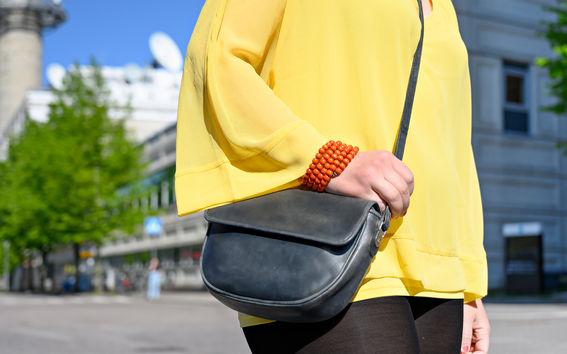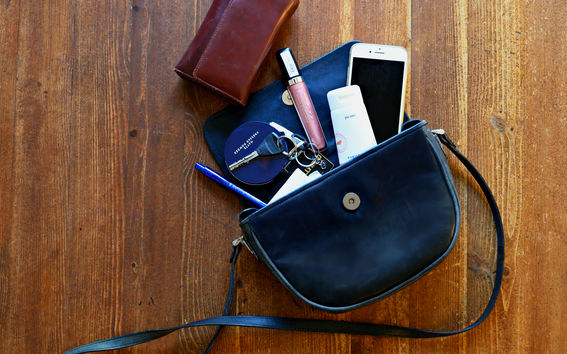The handbag – a contemporary marketplace icon

Phone, tissues, wallet, pen and keys. These daily necessities – and many others – are in most women’s handbags. But how has the handbag become the consumer product and desired object it is today?
‘The handbag’s journey from a medieval belt pouch to a branded fashion product is long and winding. Societal development has influenced both the appearance of the handbag and its significance in a woman's life’, says Laura Rosenberg, Doctoral Candidate in Marketing.
The journey from product to icon is a long process
Rosenberg is interested in people's relationship with products and their significance to a person. For her doctoral dissertation, she is investigating the services of sharing economy, such as clothing rental services. She is also interested in why people still want to own things like handbags.

Part of Laura Rosenberg’s current doctoral dissertation is an article that discusses the history of the handbag, recently published in the Consumption Markets & Culture journal. The idea of focusing on this topic came from Eric Arnould, Senior Fellow at the Department of Marketing, who had for some time been interested in handbags as a phenomenon. The article was published together with Arnould as well as Saara-Maija Järvelä, who recently graduated with a Master's degree at Aalto, and postdoctoral researcher Linda Turunen. Their aim was to demonstrate that handbags are marketplace icons – meaning brands, products or services that are historically significant because of their cultural significance – and to explain how the handbag became an icon.
‘How items develop into icons is often a long process. For the handbag, it is impossible to name a specific moment when it became a marketplace icon, because it has gained iconicity through different stages of history, such as women's entry into the labour market, which emphasised practicality, or times when brands have been used to stand out’, Rosenberg says.
Public and intimate dimension
Personally, Laura Rosenberg does not own any especially important handbag; she mainly uses a backpack. In fact, the handbag has been an interesting subject precisely because the researcher herself has been somewhat of an outsider to the subject under study. For Rosenberg, the most interesting thing has been the extent to which handbags are used for many different purposes today. And that they may have several different simultaneous purposes.
‘First of all, a handbag communicates external information. How you match your clothes and handbag relates to communication and status. At the same time, there are very intimate things in the bag, and women use the items carried in their bags for different life projects, both at work and in their free time. Few items are as multidimensional and relevant from as many perspectives as the handbag.’
Carrying tool and symbol of femininity
Let's return to the history of the handbag. It is fairly well known since the Middle Ages, but only in Europe.
In the Middle Ages, both women and men carried pouches on their waists, and already during those times, the bag served as both a practical carrying tool and an indicator of social status. The smaller the bag, the higher the social status, as the upper class did not have to carry any work tools.
In the 16th and 17th century, hidden pockets replaced the visible pouches for both women and men, but visible bags became fashionable once more in France in the 18th century, especially among women. They were initially considered daring, as the hidden pocket had been considered very intimate. In their bags made of silk, velvet or other luxurious materials, upper-class women carried essential items such as perfume, fan and calling cards. At this stage, the bag became a paradoxical object: it was revealing and concealing at the same time, and the bag became a symbol of femininity.

Indicator of emancipation and means of self-expression
In the late 19th century, the handbag started to transform into a symbol of women's emancipation and economic independence. As women entered working life in large numbers, and some also achieved economic independence, handbags became very practical once more. The appearance of handbags changed as well when manufacturers started including the metal locks, chains and buckles commonly used in suitcases at the time.
The first designer bag was by Pauline Moynat, designed in 1903 for French actor Jeanne Réjane. It was the predecessor of the famous and luxurious bag named after actor Jane Birkin that was launched by Hermès in 1984.
In the 20th century, handbags began to be seen as exclusive objects. At the same time, with more and more women working and travelling on their free time, it became a symbol of women's emancipation as well as a way to carry essential items. Since the 1950s, the handbag began to transform into a fashionable product whose purpose was also to attract attention.
Today, branded handbags are a manifestation of luxury, social status and women's personal expression and achievements, and many of the pricy designer bags have become best-sellers. Expensive bags are featured in movies, TV shows and carried by celebrities, and famous vloggers showcase their bags and their contents in popular videos. On the other hand, replica handbags are also a success on the market, and numerous brands allow many women to use the handbag – a contemporary marketplace icon – as a comprehensive and subtle social signal and a means of self-expression.
More information:
Doctoral Candidate Laura Rosenberg
Aalto University School of Business, Department of Marketing
[email protected]
+350 50 475 8740
Link to the article:
Laura Rosenberg, Linda Lisa Maria Turunen, Saara-Maija Järvelä & Eric Arnould (2020): The handbag, Consumption Markets & Culture, DOI: 10.1080/10253866.2020.1756269
https://www.tandfonline.com/doi/abs/10.1080/10253866.2020.1756269
Read more news

DeployAI Partners Gather for Heart Beat Meeting in Helsinki
The European DeployAI project's partners gathered for the Heart Beat meeting hosted by Aalto University Executive Education in Helsinki.
Get to know us: Associate Professor Maria Sammalkorpi
Sammalkorpi received her doctorate from Helsinki University of Technology 2004. After her defence, she has worked as a researcher at the Universities of Princeton, Yale and Aalto.
Aalto computer scientists in ICML 2024
Computer scientists in ICML 2024